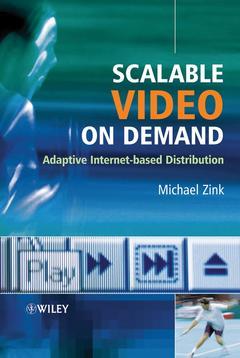Description
Scalable Video on Demand
Adaptive Internet-based Distribution
Author: Zink Michael
Language: English
290 p. · 15.8x23.5 cm · Hardback
Description
/li>Contents
/li>Biography
/li>
Scalable Video on Demand: Adaptive Internet-based Distribution examines how current video compression and streaming can be used to deliver high-quality applications over the Internet. In addition to analysing the problems of client heterogeneity and the absence of Quality of Service in the Internet, this book:
- assesses existing products and encoding formats;
- presents new algorithms and protocols for optimised on-line video streaming architectures;
- includes real-world application examples and experiments;
- sets out a practical ?toolkit? for Dynamically Reconfigurable Multimedia Distribution Systems.
Written by an expert in the field of video distribution, Scalable Video on Demand: Adaptive Internet-based Distribution provides a novel approach to the design and implementation of Video-on-Demand systems for Software Engineers and researchers. It will also be useful for graduate students following Electronic Engineering and Computer Science courses.
List of Tables.
About the Author.
Acknowledgements.
Acronyms.
1 Introduction.
1.1 Why Scalable Internet Video on Demand Systems?
1.2 What is the Goal of this Book?
1.3 Outline of this Book.
1.4 Who is this Book for?
2 Scalable Adaptive Streaming Architecture.
2.1 Distributed Systems.
2.2 Replication.
2.3 Video Distribution System Terminology.
2.4 Architecture.
2.5 Scenario for Scalable Adaptive Streaming.
2.6 An Example Application for Scalable Adaptive Streaming.
3 Towards a Scalable Adaptive Streaming Architecture.
3.1 Products.
3.2 Standardization.
3.3 Content Scalability–Scalable Encoded Video.
3.4 Congestion Control–TCP-friendliness.
3.5 Adaptive Streaming–Streaming Layer-encoded Video without Caches.
3.6 System Scalability–Caches.
3.7 Reliable Transport into Caches.
3.8 Cache Clusters.
4 Quality Variations in Layer-encoded Video.
4.1 What is the Relation between Objective and Subjective Quality?
4.2 Quality Metrics for Video.
4.3 Test Environment.
4.4 Experiment.
4.5 Results.
4.6 The Spectrum.
4.7 Implications for MDC and FGS.
4.8 Summary.
5 Retransmission Scheduling.
5.1 Motivation.
5.2 Optimal Retransmission Scheduling.
5.3 Heuristics for Retransmission Scheduling.
5.4 Viewer-centric Retransmission Scheduling.
5.5 Simulations.
5.6 Cache-centric Retransmission Scheduling.
5.7 Cache-friendly Viewer-centric Retransmission Scheduling.
5.8 Summary.
6 Polishing.
6.1 Motivation.
6.2 Polishing and its Applications.
6.3 Existing Work on Polishing.
6.4 Optimal Polishing.
6.5 Simulations.
6.6 Summary.
7 Fair Share Claiming.
7.1 Motivation.
7.2 Performing TCP-friendly Streaming in Combination with Retransmissions.
7.3 Implementation Design for FSC.
7.4 Summary.
8 Scalable TCP-friendly Video Distribution for Heterogeneous Clients.
8.1 Motivation.
8.2 Transport Scenarios.
8.3 Scalable Streaming Implementations.
8.4 Implementation.
8.5 Experiments.
8.6 Summary.
9 Improved Video Distribution in Today’s Internet.
9.1 Improvements through Scalable Adaptive Streaming.
9.2 Outlook.
Appendix A: LC-RTP (Loss Collection RTP).
A.1 Motivation.
A.2 Protocol Set for Streaming Media.
A.3 LC-RTP Design.
A.4 Use and Integration of Protocols.
A.5 Tests.
A.6 Summary.
Appendix B: Preliminary Subjective Assessment.
B.1 Execution of the Preliminary Assessment.
B.1.1 DSIS Method.
B.1.2 SC Method.
B.2 Selection of the Test Method.
B.2.1 Content.
Appendix C: A Toolkit for Dynamically Reconfigurable Multimedia Distribution Systems.
C.1 Motivation for a Video Distribution Testbed.
C.2 Terminology.
C.3 Design.
C.4 Evaluation.
C.5 Summary.
References.
Index.
Michael Zink is currently a postdoctoral fellow in the Computer Science Department at the University of Massachusetts in Amherst. Before, he worked as a researcher at the Multimedia Communications Lab at Darmstadt University of Technology. He works in the fields of sensor networks and distribution networks for high bandwidth data. Further research interests are in wide-area multimedia distribution for wired and wireless environments and network protocols. He is one of the developers of the KOMSSYS streaming platform. He received his Diploma (MSc) from Darmstadt University of Technology in 1997. From 1997 to 1998 he was employed as guest researcher at the National Institute of Standards and Technology (NIST) in Gaithersburg, MD, where he developed an MPLS testbed. In 2003, he received his PhD degree (Dr.-Ing.) from Darmstadt University of Technology, his thesis was on "Scalable Internet Video-on-Demand Systems".




